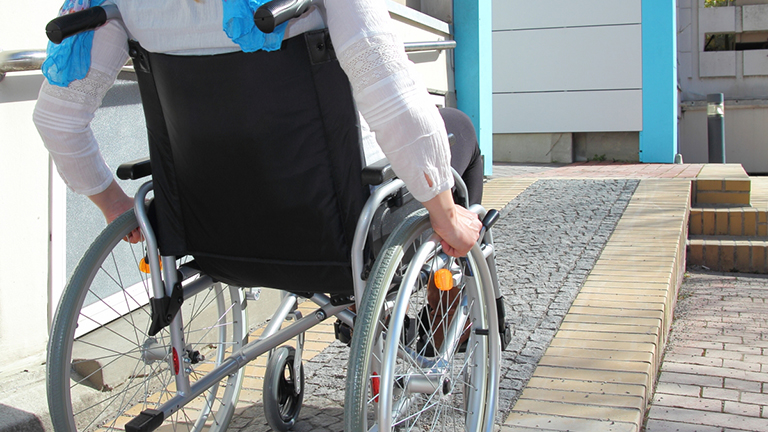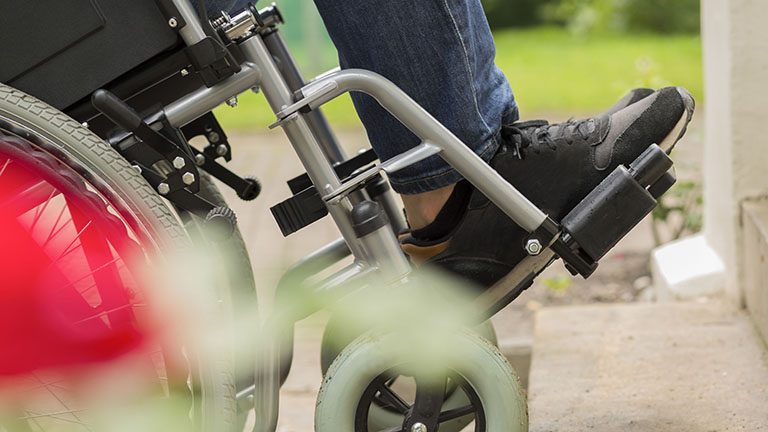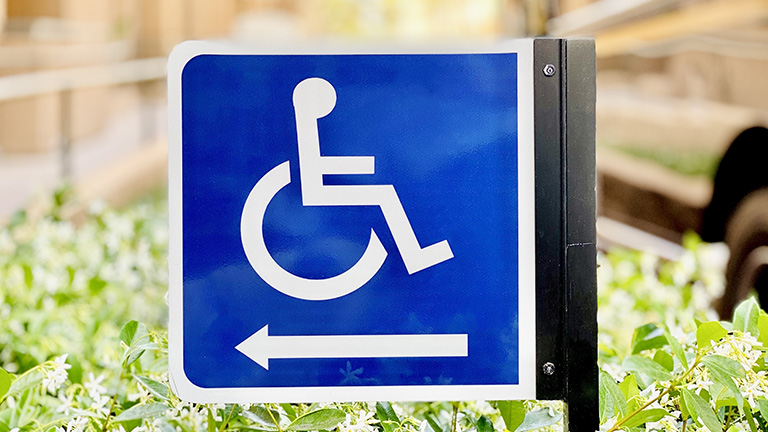Regardless of whether you are the business owner, the architect, or the contractor for a project, your primary concern is always how to best accommodate the end user. One way to address this concern is to ensure that your building is accessible to all, including those in wheelchairs.
Although ramps are often appropriate solutions to accessibility challenges, there are times when a ramp will either be too large or cost far more than a platform lift. On the other hand, there are situations when installing a platform lift may be impractical or impossible. Thus, there are many factors to consider before deciding upon a potential solution.
Below we explore some of the strengths and weaknesses of platform lifts and wheelchair ramps in an effort to facilitate your decision-making process:
Wheelchair Ramps
| Ramp Pros | |
|---|---|
| Usable with Freight | A ramp will support individuals pushing packages or transporting goods. |
| Usable in New Builds | Ramps may be installed into new structures to facilitate or enhance accessible paths of travel. |
| Low Elevation Changes | Ramps are the preferred method for overcoming low elevation changes (less than one foot), such as store fronts, house entrances, and sidewalks. |
| Cost | Smaller ramps used to overcome low elevation changes (12”or less) may be installed inexpensively while still adhering to legal requirements. |
| Ramp Cons | |
|---|---|
| Aesthetics | Ramps are not always aesthetically pleasing, especially when used to overcome large elevation changes. In addition, building materials that match a property may not be available when building and installing ramps for renovations or remodels, leading to an incongruous aesthetic. Furthermore, the construction required to install a ramp may significantly alter a property or depreciate its value. |
| Space | Due to the Americans with Disabilities Act Accessibility Guidelines (ADAAG), installing a wheelchair ramp often demands a great deal of space. Furthermore, allocating so much space to a ramp often becomes a problem for businesses that could otherwise use the area for retail space or for buildings in locations where space comes at a premium, such as in Manhattan, Los Angeles, or any other densely populated urban environments. |
| Ease of Use | Generally speaking, any ramp with a rise greater than 18” – 24” may be difficult to use for those with mobility difficulties or those with health-related issues, such as heart complications, emphysema, severe asthma, and arthritis. |
| Large Elevation Changes | Due to the large amount of space required for installation, as well as the degree of difficulty in using a long ramp, wheelchair ramps are often inadequate for overcoming large elevation changes of 2’ or more. In addition, a wheelchair ramp will not provide access to all levels of a multi-story building. |
| Mobility | Portable wheelchair ramps usually require several people a large amount of time to assemble and to disassemble, and therefore can be difficult to move. In addition, portable ramps often take up significant space to store. |
Platform Lifts
| Platform Lift Pros | |
|---|---|
| Aesthetics | Platform Lifts can often be installed in inconspicuous locations. In addition, platform lift design is often intentionally styled to effectively incorporate into any location with a similarly sleek and modern appeal to match contemporary architectural tastes. Furthermore, for historic locations or high-profile venues, such as concert halls or museums, many lifts are designed to be unobtrusive. Such a design preserves the dignity and appeal of both the lift’s user, as well as the facility. |
| Space | Although somewhat varied between manufacturers, the footprint of a platform lift is generally within 48” by 70”. This compact size enables a platform lift to accommodate a facility with a small floor area. |
| Mobility | Some platform lifts are available as portable models. As a result of their compact size and easy mobility, portable lifts are capable of being transported from one location to another, as needed, and then can be moved into storage. Portable models are best suited for stadiums, schools, or organizations, such as convention centers or custom stage companies. |
| Ease of Use | Lifts provide accessible use for individuals living with mobility difficulties as well as for those with a range of other medical conditions that may make using stairs or ramps difficult, such as arthritis, emphysema, or heart complications. Furthermore, platform lifts are designed to be used without the need of a full range of motion in the hand, wrist, or arm. |
| Large Elevation Changes | Lifts are capable of easily overcoming a wide range of elevation changes, including between levels within multi-story buildings. Some platform lift models are capable of rising up to 14’. |
| Dignity | Due to their compact nature and aesthetically-minded design, platform lifts maintain a user’s dignity by providing a system for independent usage. |
| Platform Lift Cons | |
|---|---|
| Not Fully Usable in New Buildings | In most cases, platform lifts are not permitted by law to be installed during construction of new buildings. Rather, they are commonly installed as an accessibility solution during remodels or alterations. However, there are a few instances when a platform lift may be permitted in new constructions. These instances may be found at the Access-Board website. |
| Installation Pits and Entry Ramps | The device responsible for stopping a platform lift’s decent after encountering an obstruction, the under platform safety pan, protrudes from the bottom of the lift on most lift models. This causes the lift to sit above the ground, requiring a small entry ramp to facilitate easy entry into the lift. Without the ramp, a lift will require a 3” “installation pit” to be dug into the floor in order to accommodate the pan and provide floor-level entry into the lift. In renovations or historic remodels, this pit is often difficult to accommodate. However, platform lifts designed for ground-level access without a pit or ramp are available. See the platform lift comparison chart for more information. |
| Freight Transport | The design of a platform lift is not conducive to the safe transportation or support of heavy freight and industrial cargo. Rather, platform lifts are designed to conform to civil rights laws as well as specific safety regulations, which do not pertain to the handling of freight. |
| Initial Cost | The initial upfront cost of a lift, including purchase and installation, may be expensive. |
*Note: Due to many of these issues, the use of ramps provides neither a required ease of use nor a level of user dignity.
Additional Resources:
- For code requirements regarding accessibility in any facility, see the United States Access Board website.
- Ascension is a platform lift manufacturer that designs lifts that provide ground level entrance without an installation pit and offers a high level of safety.
- For information regarding code requirements and design suggestions for wheelchair ramps, Lowes’ website is a terrific resource.



